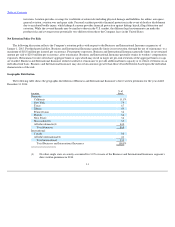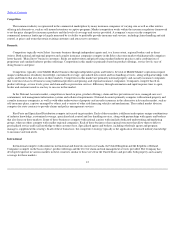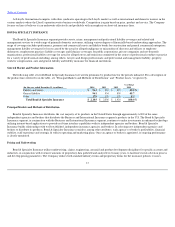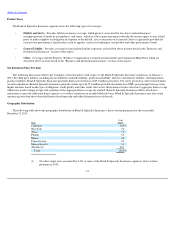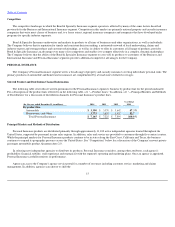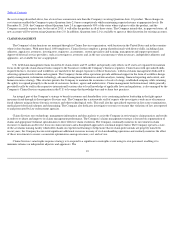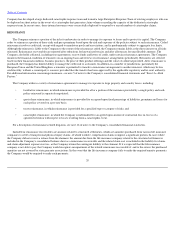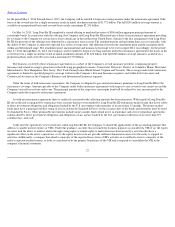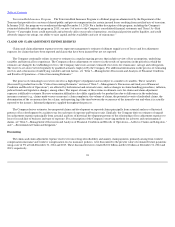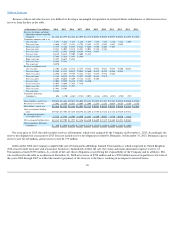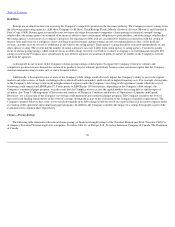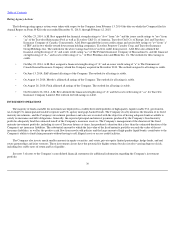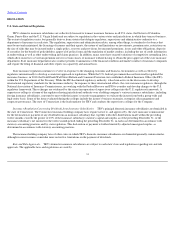Travelers 2014 Annual Report Download - page 22
Download and view the complete annual report
Please find page 22 of the 2014 Travelers annual report below. You can navigate through the pages in the report by either clicking on the pages listed below, or by using the keyword search tool below to find specific information within the annual report.
Table of Contents
Catastrophe Reinsurance
Catastrophes can be caused by a variety of events, including, among others, hurricanes, tornadoes and other windstorms, earthquakes, hail,
wildfires, severe winter weather, floods, tsunamis, volcanic eruptions and other naturally
-
occurring events, such as solar flares. Catastrophes can
also result from terrorist attacks and other intentionally destructive acts (including those involving nuclear, biological, chemical or radiological
events), explosions and infrastructure failures. The incidence and severity of catastrophes are inherently unpredictable. The extent of losses from a
catastrophe is a function of both the total amount of insured exposure in the area affected by the event and the severity of the event. Most
catastrophes are restricted to small geographic areas; however, hurricanes and earthquakes may produce significant damage in larger areas,
especially those areas that are heavily populated. The Company generally seeks to manage its exposure to catastrophes through individual risk
selection and the purchase of catastrophe reinsurance. The Company utilizes corporate catastrophe excess
-
of
-
loss reinsurance treaties with
unaffiliated reinsurers to manage its exposure to losses resulting from catastrophes and to protect its capital. In addition to the coverage provided
under these treaties, the Company also utilizes catastrophe bonds to protect against hurricane losses in the Northeastern United States, and a
Northeast catastrophe reinsurance treaty to protect against losses resulting from weather
-
related and earthquake catastrophes in the Northeastern
United States. The Company also utilizes excess
-
of
-
loss treaties to protect against earthquake losses up to a certain threshold in the Business and
International Insurance segment (for certain markets) and for the Personal Insurance segment, and several reinsurance treaties specific to its
international operations.
Corporate Catastrophe Excess
-
of
-
Loss Reinsurance Treaty. For the period January 1, 2015 to December 31, 2015, the Company has entered
into a reinsurance agreement that covers the accumulation of certain property losses arising from one or multiple occurrences: 75% ($1.50 billion) of
qualifying losses covered by the treaty and 25% ($500 million) of qualifying losses retained by the Company part of $2.0 billion excess of
$3.0 billion. Qualifying losses for each occurrence are after a $100 million deductible. The treaty covers all of the Company's exposures in the United
States and Canada and their territories and possessions, the Caribbean Islands, Mexico and all waters contiguous thereto. The treaty only provides
coverage for terrorism events in limited circumstances and excludes entirely losses arising from nuclear, biological, chemical or radiological attacks.
This treaty replaced the Company's General Catastrophe Reinsurance Treaty, which was cancelled on a cut
-
off basis effective December 31, 2014,
and the General Catastrophe Aggregate Excess
-
of
-
Loss Reinsurance Treaty, which expired on December 31, 2014.
Catastrophe Bonds. The Company has catastrophe protection through two indemnity reinsurance agreements with Long Point Re III Ltd.
(Long Point Re III), an independent Cayman Islands company licensed as a Class B insurer in the Cayman Islands. The reinsurance agreements
expire in June 2015 and May 2016, respectively, and provide coverage to the Company for certain losses from a hurricane in the northeastern
United States. Both reinsurance agreements meet the requirements to be accounted for as reinsurance in accordance with the guidance for
reinsurance contracts. In connection with each reinsurance agreement, Long Point Re III issued notes (generally referred to as "catastrophe
bonds") to investors in an amount equal to the full coverage provided under the respective reinsurance agreement as described below.
On June 6, 2012, Long Point Re III completed an offering to unrelated investors of $250 million aggregate principal amount of catastrophe
bonds. In connection with the offering, the Company and Long Point Re III entered into a three
-
year reinsurance agreement providing coverage to
the Company for certain losses from a hurricane in the northeastern United States. The proceeds of the offering were deposited in a reinsurance
trust account. The attachment point, maximum limit and insurance percentage are reset annually to maintain modeled probabilities of attachment
and expected loss on the respective catastrophe bonds equal to the initial modeled probabilities of attachment and expected loss. The attachment
point, maximum limit and insurance percentage were reset in April 2014. Accordingly,
21


